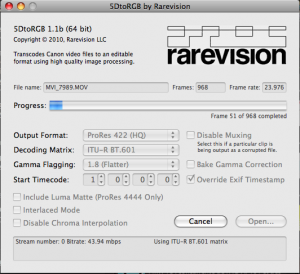
I have access to Compressor, and also have MPEG Streamclip
5DTORGB GH2 32 BIT
I've scoured the forums for answers, but haven't really found what I am looking for.Īs the title suggests, I've been trying to find a high quality solution for converting H.264 to an editable (edible mmmm) format of the highest quality with the least amount of degradation and color/gamma/whatever changes.īackground info: editing on a 32 bit Macbook with 2 GB RAM and a 2 GHz Intel Core Duo processor. But if Avid read's the source file wrong (due to QT related issues) the rec709 setting doesn't help at all. You can only choose to remap from fullswing to studioswing ("RGB" settings) or you can choose not to remap levels (rec709 setting). but it's a pitty that Avid's import tool (or AMA Plugin) doesn't offer a switch as the one provided in 5DtoRGB. So with 5DtoRGB you can also transcode to ProRes and still preserve studioswing. In 5DtoRGB you have the option to preselect whether the source file is studioswing or fullswing. EDIT: transcoding through FFmpeg to ProRes also preserves the original levels! Alternatively you can transcode to ProRes through FFmpeg. FFmpeg even transcodes to DNxHD-x, so 10bit). You can transcode to DNxHD through FFmpeg and get proper studioswing (by the way.

exactly!įor instance FFmpeg bypasses QT tags (set for vieweing purposes) of the source file. It would be great if somehow Avid could get the core media, bypassing any 'corrections' on the QT end. GH3 shadows + curve (tone curve applied to the iFFmpeg import on the right side to utilze fullswing levels): GH3 shadows (tone curve applied to the iFFmpeg import on the right side to utilze fullswing levels): GH3 patches + curve (tone curve applied to the iFFmpeg import on the right side to utilze fullswing levels): GH3 patches (tone curve applied to the iFFmpeg import on the right side to utilze fullswing levels): Or maybe I am doing something wrong.? (but honestly I don't think so as I am pretty familar with the studio- vs. since right now the only way to preserve the original levels is to first transcode the footage to DNxHD using an external tool (in my case iFFmpeg). Which was a good thing!! … IMO… since this way the actual luminance levels of the original footage has been preserved.īut apparently MC 6.5 (…) now seems to read flags and tags in AVCHD footage and therefore direct import doesn't work correctly anymore. I was under the impression Avid MC (5.5 …) ignores flags and tags in mov and MTS files. To make the issue more obvious I've applied a tone curve to both of the screenshots in a second copy.

The direct import clearly shows crushed shadows and banding… while the iFFmpeg conversion to DNxHD shows smooth transitions and a higher differentiation in dark tonal values.
5DTORGB GH2 FULL
To illustrate the issue I've attached screenshots of some test footage directly imported into MC 6.5.3 versus footage first transcoded to DNxHD (185x, 25p) through iFFmpeg and then fast imported into Avid MC (since the forum layout crops the screenshots please open the attchments in a seperate tab to view the full images.). However, Avid MC (6.5.3) is clipping blacks on direct import (though import settings are set to rec 709).

The Panasonic GH3 also records video in studioswing but the files (*.mov files) are labelled with a fullswing tag for viewing purposes on a computer screen. Now, on MC 5.5 (xy…) everything went fine with GH2 footage (MTS files recorded in studioswing have been imported accordingly into Avid MC). fullswing thing can be with AVCHD … especially on MAC. I think we all know how weird the studio vs. Based on the hope that one of the Moderators passes this on to Avid I'll report an issue with AVCHD Import into Avid MC (applies at least to versions 6.5.2 to 6.5.3).


 0 kommentar(er)
0 kommentar(er)
